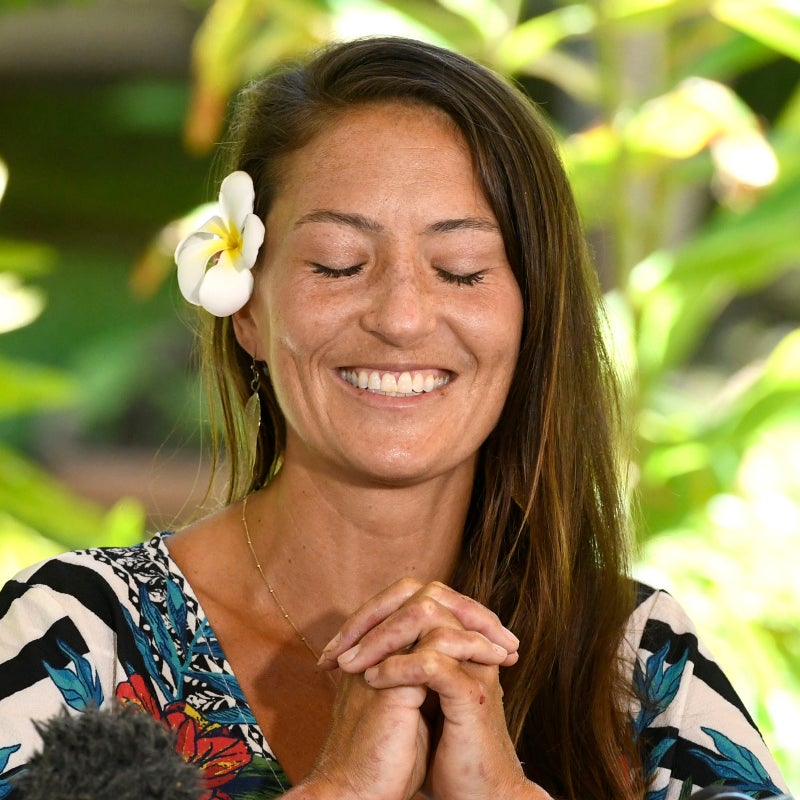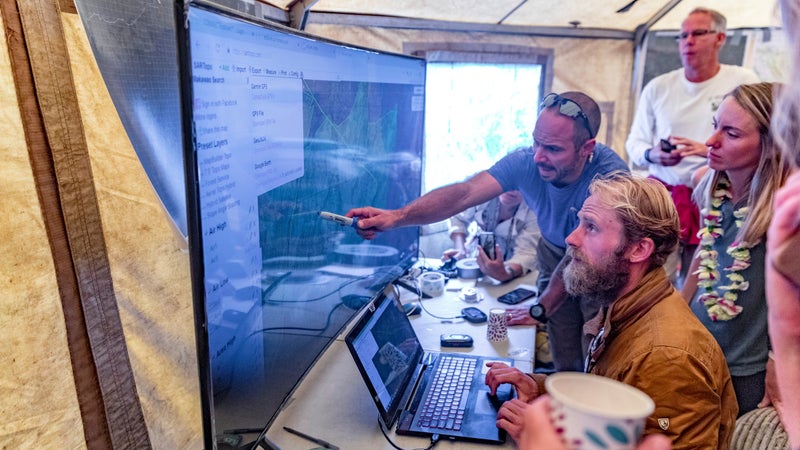In the early morning hours of May 29, a helicopter circled Mauna Kahalawai, on the Hawaiian island of Maui, deploying Forward-Looking Infrared Radar (FLIR) to detect any sign of life. The searchers were looking for a local hiker who had been missing for nine days.
The missing person was not Amanda Eller, the yoga instructor and physical therapist who now famously survived 17 days in the Hawaiian backcountry in a tank top and capris. It was 35-year-old local man Noah ÔÇťKekaiÔÇŁ Mina who, on May 20, set out on the unmarked Kapilau Ridge Trail, also known as the Iao Valley Secret Trail, roughly 20 miles away from the command headquarters for EllerÔÇÖs search. ╠ř
But the searchersÔÇöan unemployed arborist, a former╠řArmy Ranger and scuba instructor, and a rappelling guideÔÇöwere the same.
To paraphrase╠řRobert Koester, a.k.a. Professor Rescue and the╠řauthor of , the Bible of search and rescue, a runner tends to run themselves out of the search area pretty fast. ThatÔÇÖs just what Eller, 35, did on May 8. SheÔÇÖd intended to do a routine three-mile trail run in the Makawao Forest Reserve, a 2,000-acre rainforest that shoulders the massive Haleakala volcano on the Hawaiian island of Maui. Eller, a local, ducked down a little side path for a meditation break. When she stood up to continue on the main trail, she got turned around, forgetting which way sheÔÇÖd come in. And as outdoor athletes can and sometimes do, she pushed herself swiftly and confidently in the wrong direction, determined not to backtrack, so that her hourlong outing turned into a 17-day bushwhack from hell.
After her boyfriend, Benjamin Konkel, reported her missing to the Maui police department on the morning of May 9, authorities located EllerÔÇÖs white 2015 Toyota RAV4 at the HunterÔÇÖs Trail trailhead. Her phone, wallet, and water bottle were locked inside the car. Her car key was found hidden behind a tire. This wasnÔÇÖt necessarily unusualÔÇöshe wouldnÔÇÖt need her phone on a short╠řfamiliar route, and the only thing you can do with a car key in the forest is lose it. There was no immediate sign of foul play; Konkel took a lie-detector test and passed.

According to the federal (NamUs), Hawaii ranks eighth in the United States in number of missing persons. (Alaska is far and away number one.)╠řWhereas in most of the United States the county sheriff is in charge of search and rescue, in Hawaii╠řthe sheriff division of the Hawaii Department of Public Safety acts more like a state police. On Maui, the county fire department is in charge of search and rescue. The Maui police department and the Maui County Department of Fire and╠řPublic Safety were joined by dog teams from the volunteer organization Maui Search and╠řRescue. In a matter of hours there were helicopters, drones, dogs, and trained boots on the ground. Dozens of volunteers showed up to help scour the trails.
ÔÇťWe would take anybody who could walk,ÔÇŁ says Sarah Haynes, a friend who was deputized into helping organize the search and taking the role of family spokesperson while EllerÔÇÖs parents, John and Julie, were unreachable for the first two days while on a diving trip. ╠ř╠ř
At first╠řall those searchers were organized under the direction of Maui Fire, who are well versed in incident command. But on╠řMay 11, mandated by a 72-hour limit on rescue-personnel efforts, Maui Fire had to pull the plug on the official search. As of Sunday, May 12, the volunteers were on their own, an army without an officer. ThatÔÇÖs when arborist Chris Berquist, 33, and Javier Cantellops, 37, a former╠řSpecial Operations Army Ranger, scuba instructor, and free diver whoÔÇÖd taught scuba to Eller, stepped in. ╠ř╠ř
IÔÇÖve studied myriad missing-person searches while researching my forthcoming book, The Cold Vanish (Grand Central Publishing, 2020). Searches are like snowflakes in that no two are alike, but the hunt for Amanda Eller was specialÔÇöonly in part because she survived.
In most cases, after the official search is called off and the incident command goes home, the effort is left to family, friends, and sometimes a handful of locals who want to help. The lost person is at the mercy of familial and demographic privilege; in short, who looks for you when the pros go home is a crapshoot. Some searches get a figurative shot of vitamin B when an incident-command expert steps in to run an intensive two- or three-day ad hoc search. The Jon Francis Foundation, a Minnesota-based nonprofit that helps families of persons missing in the wild, will sometimes organize a skilled search of seven to ten days. Neal Keller, father of runner Joe Keller, who disappeared in the San Luis Valley of Colorado in 2015, would fly out from his home in Tennessee to take lonely hikes and horseback rides in the mountains until JoeÔÇÖs body was found in 2016. Professional adventurer Roman Dial utilized his skillset to search for his son Cody, who vanished in 2014 in the Costa Rican jungle; CodyÔÇÖs body was found two years later. Randy Gray, a surfer whose son Jacob went missing on his bicycle in WashingtonÔÇÖs╠řOlympic National Park╠řin 2017, left his contracting job to turn over every rock in the Sol Duc River looking for his son.
But these are exceptions, not the rule. And what made the search for Eller especially unique was the army of fit, motivated islanders and the sacrifices made by Cantellops and Berquist, who didnÔÇÖt even know Eller when she vanished. ÔÇťWe need people who are comfortable being outside six to eight hours a day,ÔÇŁ Berquist told ╠řfrom the operations yurt that was erected on site. There were 60 to 150 searchers there every day for two solid weeks. And the spirit was such that they would have stayed longer.
Out came the psychics. The trail of any missing person in the wild is paved with psychics. Most of them saw her dead. They saw men with tattoos. They saw her tied up and being thrown off a cliff.
At first, after Maui Fire packed up, things were as DIY as homemade soap. But ÔÇťChris showed up and the next thing you know heÔÇÖs on the other side of the table,ÔÇŁ Haynes says of Berquist. ÔÇťIt quickly exploded and we got a small team of people together who then had hundreds of people under them.ÔÇŁ
Soon the camp looked like an aid station at an ultramarathonÔÇötables lined with energy drinks and piled with nutrition bars╠řand donated sandwiches from local restaurants. A generator hummed behind the yurt. People shuttled╠řin the most precious commodity for a tropical emergency like this: ice, to keep searchers cool in the humid 90-degree heat. FAA-certified drone pilots flew cameras over the forest canopy. Experienced hikers and fast packers were able to cross off chunks of map. Rappellers spidered down cliffs; free divers checked ponds and pools. Hunters even killed boars and examined their intestines. Maui Search and╠řRescue ran dog teams. A GoFundMe site raised more than $70,000 to help offset private helicopter costs, which can run over $1,000╠řan hour. And Berquist is quick to point out that members of Maui Fire were still assisting behind the scenes even after they had to officially step down.
Who keeps track of all that activity, all that searching? Berquist and Cantellops started with a flip phone and a legal pad. With the help of Haynes and Elena Pray, 29, a rappelling guide for Rappel Maui, they began by handing out paper ÔÇťpirate mapsÔÇŁÔÇöX marks the spot, with a hairball problem of solving for X. All volunteers had to be checked in, accounted for, and checked out. Their routes and notes had to be logged and added to the map. When needed, Pray would be called to rappel into an area. ÔÇťOne afternoon we assisted a group of searchers out of a deep gulch using technical rope gear just minutes shy of darkness,ÔÇŁ she told me. One volunteer, Stephie Garrett, went from yurt ops to being a search-team leader. A Swiss tourist named Susann Schuh spent her vacation organizing data for stacked 12-hour days.
Gradually computers were plugged in and the team utilized apps that allowed coordinators to color in specific areas that had been scoured, aided by the tech expertise of EllerÔÇÖs father, John, an executive in telematics, the intersection of communications and information technology. Troy Helmer, a local hunter, scouted the topography and consulted on the battle plan. ÔÇťTroy knows that area better than anyone in Maui,ÔÇŁ Cantellops told me.
Still, for two weeks╠řthe searchers found nothing. Surveillance cameras at a grocery store in Haiku showed Eller shopping the morning of May 8. A time stamp on a package placed her at the post office. Police reviewed video footage from doorbell security cameras on the road from Haiku to Makawao to see if she had been abducted or followed. ÔÇťShe was alone in the car and having a normal day,ÔÇŁ Haynes says, ÔÇťso we felt strongly that she took herself to the forest in unsuspicious circumstances.ÔÇŁ Hikers reported having seen EllerÔÇöthey╠řchatted briefly and she╠řpet their dog.
Still, it was hard to not think of foul play. When OccamÔÇÖs razor doesnÔÇÖt prove out quickly, the void left by a vanished person is quickly filled with speculation. Armchair investigators on Facebook and Websleuths╠řfigured that if she hadnÔÇÖt fallen down a lava tube or been eaten by wild pigs, sheÔÇÖd surely been abducted. The boyfriend must have offed her, they theorized, and cheated on the polygraph. Or it could have been an ex. A jealous coworker. She probably stumbled across one of many illegal marijuana operations. Maybe there was a serial killer on the loose.
And out came the psychics. The trail of any missing person in the wild is paved with psychics. Most of them saw her dead. They saw men with tattoos. They saw her tied up and being thrown off a cliff. ╠ř╠ř
EllerÔÇÖs case reminded me of Amy BechtelÔÇÖs disappearance╠řin the Wind River Range of Wyoming in 1997. Both women were runners. Both left valuables in their white Toyotas at a place where they presumably parked to run. Both had partners who were suspected of foul play, and tip lines flooded by psychics. As with Bechtel, whose disappearance has never been solved, chances of Eller being found alive were growing increasingly grim.
As all these theories and leads swirled around him, Berquist kept disciplined. He was so dedicated to the search that his employerÔÇöa landscaping companyÔÇöfired him. That didnÔÇÖt deter him from showing up to look for Eller day after day. ÔÇťWe are nowhere close to stopping by any means,ÔÇŁ he told Maui Now. ÔÇťWe have so much more that we can do out here, weÔÇÖre gonna continue to push it.ÔÇŁ
Lost persons, mainly deceased, are often found within an original search area. In this case, the computer mapping allowed searchers to see that theyÔÇÖd fairly saturated the original 1.5-mile radius. On the afternoon of Friday, May 24, Berquist realized he needed to plan for the Memorial Day weekend, when many more volunteers would show up to search. He thought they might need to move the yurt to another location, to push past the radius theyÔÇÖd been focusing on for the past two weeks. He, Cantellops, and Helmer climbed into pilot Pete VorhesÔÇÖs yellow Hughes 369D for a reconnaissance flight.

This was the breakthrough. ÔÇťI just felt that she was alive, man,ÔÇŁ Cantellops would tell The Today Show the following Monday. ÔÇťIf we havenÔÇÖt found her and we havenÔÇÖt smelled her, thatÔÇÖs because sheÔÇÖs on the move, sheÔÇÖs moving out and sheÔÇÖs way farther out than we think she is.ÔÇŁ
With only 15 minutes of fuel remaining, the men on the helicopter prepared to turn around. They were now outside the boundary of Makawao Forest Reserve, about seven miles from where EllerÔÇÖs car had been found. ThatÔÇÖs when they saw Eller on the riverbank, between two waterfalls, waving furiously.
Overnight, the story of EllerÔÇÖs ordeal would erupt in newspapers and on morning shows. She could see and hear helicopters, she recalled, but they never saw her. Day three╠řis when she went from panicked, lost-person mode into survival mode, searching for clean water and foraging for food. She fell 20 feet off a cliff, breaking her leg and tearing the meniscus in her knee. She was reduced to crawling. It rained, and her running shoes got swept away in a flash flood. Temperatures at night dipped to near 60, potentially hypothermic conditions when itÔÇÖs wet. She had nothing but her yoga pants and a tank top. To keep warm, she covered herself with ferns, leaves, and forest duff. She slept in a boarÔÇÖs nest.
She ate╠řplants she didnÔÇÖt know, some strawberries, and guava. For protein╠řshe swallowed an occasional moth. Maui waterfalls look fresh on postcards but can contain Leptospira, a genus of bacteria that causes a whole buffet of problems including meningitis, kidney failure, and death. But to not drink meant certain death.
Eller lost 20 pounds in those 17 days. In addition to her broken leg, she had a severe skin infection from sunburn. But thanks to the determination of friends and strangers, she is expected to make a full recovery.
On Sunday, May 26, not 48 hours after Eller was found, I got a text from Javier Cantellops. He couldnÔÇÖt talk, he said; they were getting in a helicopter╠řto look for another missing person. As with Eller, local authorities had searched for three days for Noah Mina, after he disappeared on May 20 from the Kapilau Ridge Trail. But because the terrain was so technical, MinaÔÇÖs father, Vincent, issued a statement advising against ordinary volunteers trying to find him. ╠ř
Searchers did find MinaÔÇÖs flip-flops. But, Cantellops told me, ÔÇťThatÔÇÖs not unusual. A lot of locals here hike barefoot.ÔÇŁ ╠ř
I caught up with Cantellops on Tuesday morning, as he and Berquist were gearing up to search. Elena Pray was already in the helicopter. ÔÇťThis is a totally technical search,ÔÇŁ he said. ÔÇťHelicopters with FLIR, drones. ItÔÇÖs like MinaÔÇÖs dad said: No boots on the ground.ÔÇŁ
ÔÇťThis is not a place where people go,ÔÇŁ he continued. ÔÇťSheer 2,400-foot faces. This is the most primal part of Maui. YouÔÇÖve seen the mountains in maybe North Carolina or GeorgiaÔÇösmooth, round? This isnÔÇÖt like that. This is Afghanistan, man.ÔÇŁ
But with the help of technology, the efforts of Berquist, Cantellops, and Pray paid off. This time, however, the ending was not a happy one. ÔÇťIn the early morning hours of Wednesday, May 29,ÔÇŁ read a family statement issued on the public Facebook page Bring Kekai Home, ÔÇťa crew of searchers aboard a helicopter spotted the body of missing hiker Noah ÔÇśKekaiÔÇÖ╠řMina. Mina was found about 300 feet below a fall line in the summit region of Mauna Kahalawai. Recovery efforts are currently underway.ÔÇŁ


